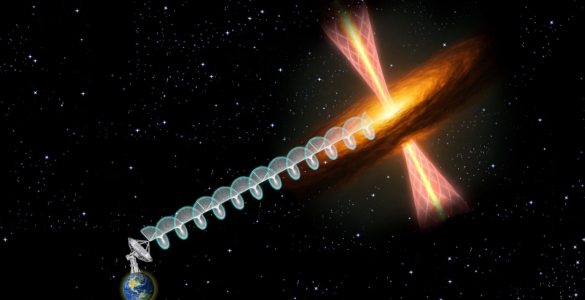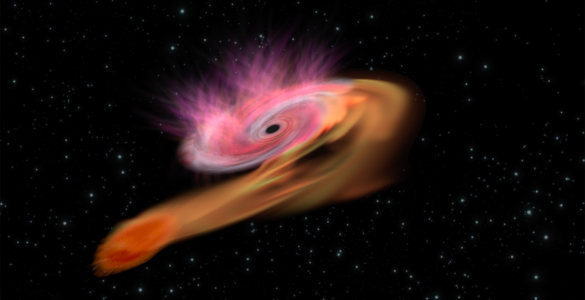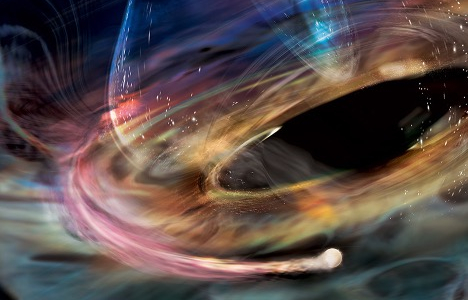Winning Entries Showcase a Fascinating Variety of Celestial Objects
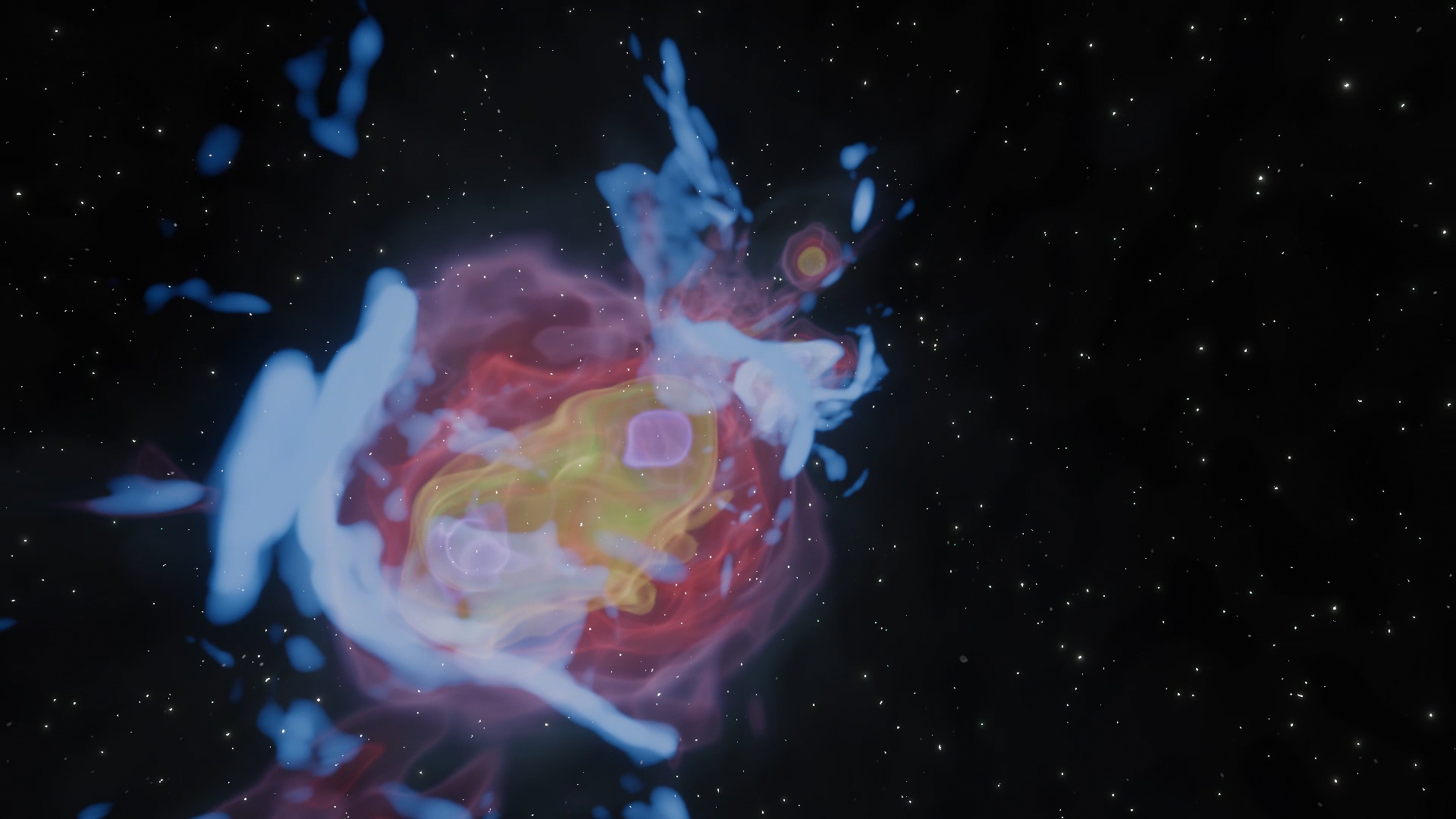
First Prize: Radio Relics in Galaxy Clusters -- Collisions -- Simulations & VLA
The most energetic events in the Universe are the collisions between clusters of galaxies — collisions that force colossal amounts of intergalactic hot gas to mix.
With sophisticated computer simulations of these events, which take place on scales of billions of years and generate shock waves as large as six million light-years, we can compare our models of the Universe with real telescope observations.
Radio observations are optimal for studying these colossal events, as copious radio emission is produced (via a mechanism called “synchrotron”) when these shocks run over the diffuse magnetic fields in the almost empty space between galaxies.
Two spectacular examples of such events, called “radio relics,” recently have been studied with deep radio observations with the VLA. Thanks to the high spatial and spectral resolution of these observations, astronomers could obtain precious information on the past lifetime of the radio-emitting particles, and they could connect this information to simulation models, in order to improve our understanding of how such majestic cosmic structures form and evolve.
Acknowledgements/Credits
Scientific data by D. Wittor (University of Hamburg – simulation), C. Stuardi, K. Rajpurohit (University of Bologna – VLA observation)
Video realized by G. Inchingolo, P. Zuzolo (University of Bologna), S. Imboden D. De Luca (CINECA Visit Lab)
Audio realized by sonification of the simulation data used for the video by J. Paradiso (MIT Media Lab)
This work was supported in part by the European Research Council under the Horizon2020 Starting Grants MAGCOW (https://cosmosimfrazza.myfreesites.net/erc-magcow) and DRANOEL (https://annalisa-bonafede.myfreesites.net/erc-stg-project-dranoel). Simulations were performed on Juwels at the Julich Supercomputing Centre based in Germany. For the creation of the video, we acknowledge the assistance of (AM)^2 research group of Prof. Serena Morigi of the Department of Mathematics of the University of Bologna and the Visit Lab of CINECA under the project FIBER OF THE UNIVERSE (http://visitlab.cineca.it/index.php/portfolio/fiber-of-the-universe/). For the creation of the soundtrack, we acknowledge the assistance of Prof. Joe Paradiso of the MIT Media Lab for the sonification of the simulation data using his massive modular synthesizer (http://paradiso.media.mit.edu/synth.html).
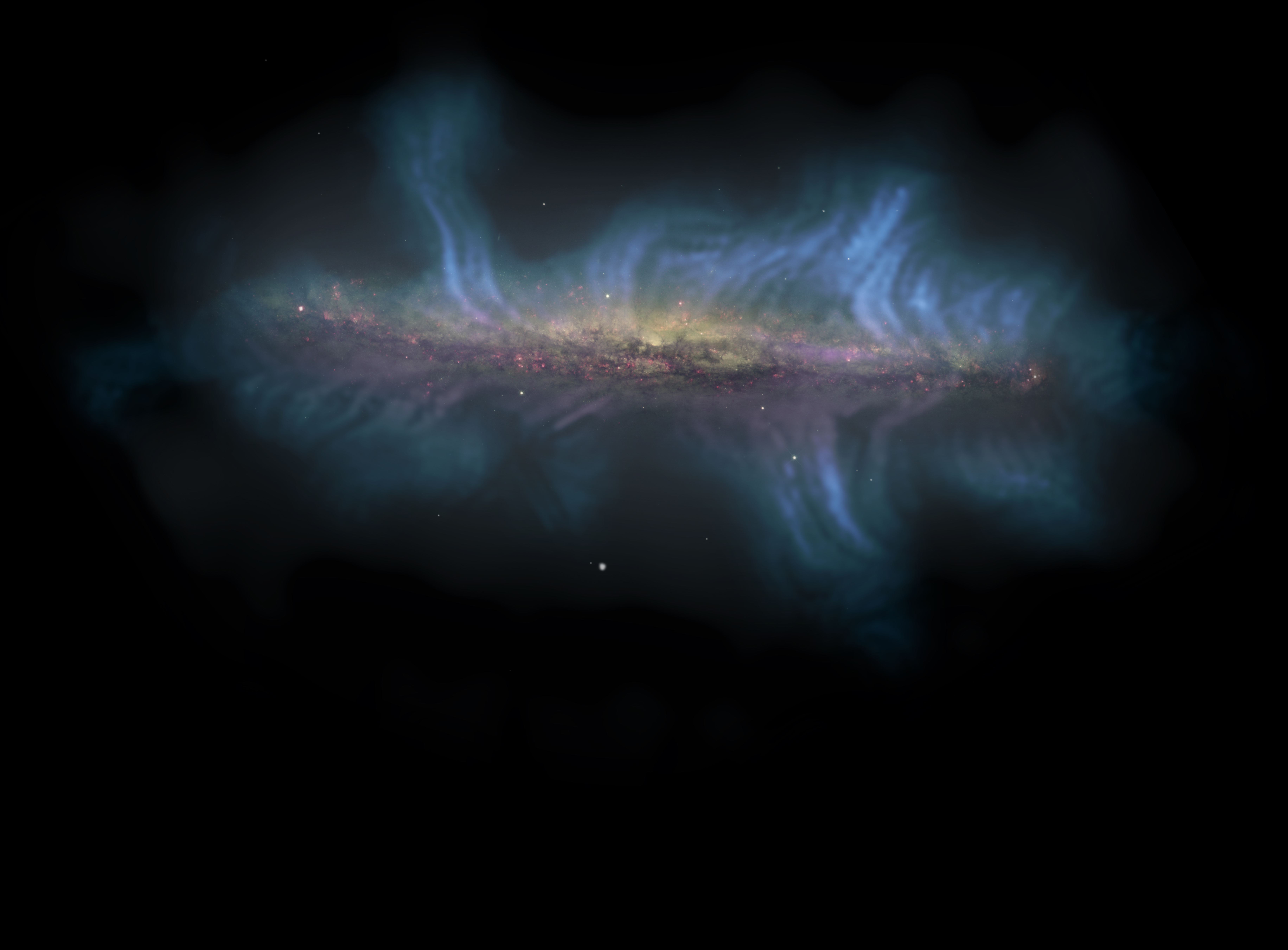
Second Prize: Magnetic Field in Galaxy NGC 5775 -- HST/VLA
The Jansky VLA traces the magnetic field structure in superb detail in the galaxy NGC 5775 due to its relative proximity (94 million light-years) and the high sensitivity of the telescope to radio radiation. NGC 5775 is also special since we have an unobstructed view of the altitudes above and below its spiral disk.
Within the disk, in the Hubble Space Telescope optical data, are bubbles of hot, ionized gas (assigned the color magenta) produced by newly-born stars. Fast moving charged particles (called cosmic rays) created in these bubbles are transported away, forming a so-called “radio continuum halo” shown here as a faint, ghostly blue-grey glow. Some cosmic rays become snagged by magnetic field lines. These lines are represented by “flow lines” (that have been converted from radio polarization vectors using a Line Integral Convolution algorithm).
The field lines start off parallel to the disk (assigned fuchsia in this region) and curve away until they are vertical. In this upper region (assigned blue) the most extended feature can be traced as high as 26,000 light-years — that is a quarter of the galaxy’s diameter! By studying the structure of the magnetic field and the radio continuum halo in NGC 5775 and other galaxies our team, “Continuum Halos in Nearby Galaxies, an EVLA Survey (CHANG-ES),” hopes to determine the origins of magnetic fields in disk galaxies and how they instigate changes in the characteristics of spiral galaxies over time.
Credit:
Composite image by Jayanne English (University of Manitoba). NRAO VLA data processed by Yelena Stein (CDS) for the Continuum HAlos in Nearby Galaxies — an EVLA Survey (CHANG-ES) led by Judith Irwin (Queen’s University, Canada). The optical data are from the Hubble Space Telescope (HST) Wide Field Camera 3 (WFC3). The software code for tracing the magnetic field lines was adapted by Y. Stein, J. English and Arpad Miskolczi (Ruhr-University Bochum) from the scipy Line Integral Convolution code (https://scipy- cookbook.readthedocs.io/items/LineIntegralConvolution.html).
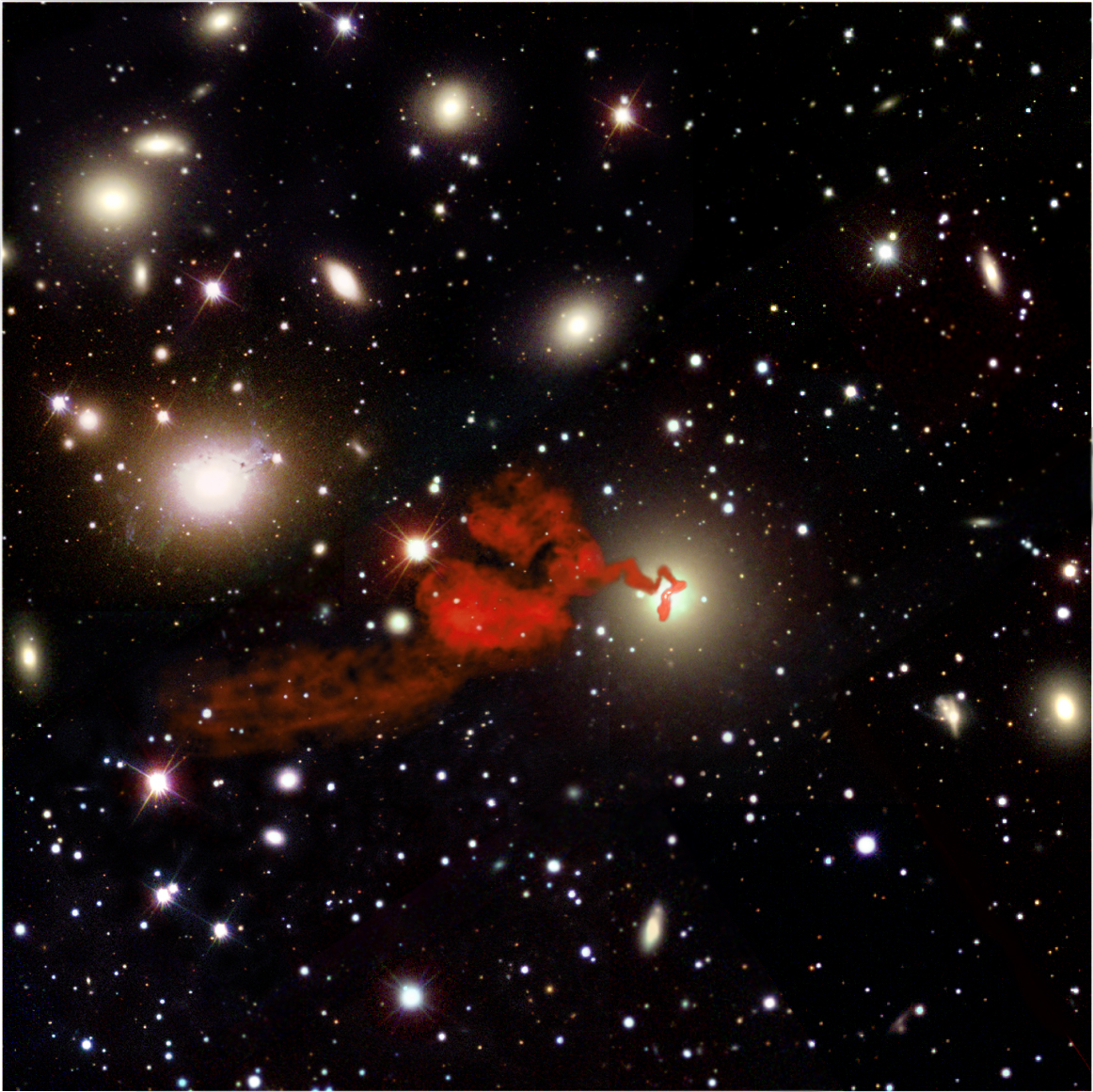
Third Prize: NGC 1272 jets in Perseus Cluster -- Sloan/VLA
Located 250 million light-years from Earth, the Perseus Cluster is a relatively nearby gathering of several hundred galaxies. In the optical background image from the Sloan Digital Sky Survey, two bright massive elliptical galaxies stand out: NGC 1275 (center-left) and its sister NGC 1272 (center).
Like many galaxies, NGC 1272 hides a powerful supermassive black hole in its center. This black hole acts as an engine powering jets of relativistic particles that propagate beyond the galaxy. Immersed into a magnetic field, these particles emit light at radio wavelengths (the wavy orange-red ribbon on the image). With its unrivaled sensitivity and resolution, the Karl G. Jansky Very Large Array has been able to fully image those jets in remarkable details.
Spanning at least over 200,000 light-years — twice the size of the Milky Way — the particles in these jets are caught in a complex choreography involving swirling eddies, narrow winding channels, and vortex-like spirals. The radio light from NGC 1272 may represent an unexpected opportunity to reveal key dynamical informations about this rich environment. Indeed, astronomers are investigating if these features are the result of the high-speed motion of NGC 1272 through the Perseus Cluster, or of particle diffusion in the turbulent, 60 million-degree plasma that lies between the cluster’s galaxies.
Paradoxically, in revealing such fine details, the radio light from NGC 1272 as observed by the Karl G. Jansky Very Large Array opens up many more questions on how these ginormous structures move and interact in our Universe.
Credits:
Sloan Digital Sky Survey (filters, colored in blue, green and red), VLA, M.-L. Gendron-Marsolais (ESO), C. L. H. Hull (NAOJ), R. Perley (NRAO).
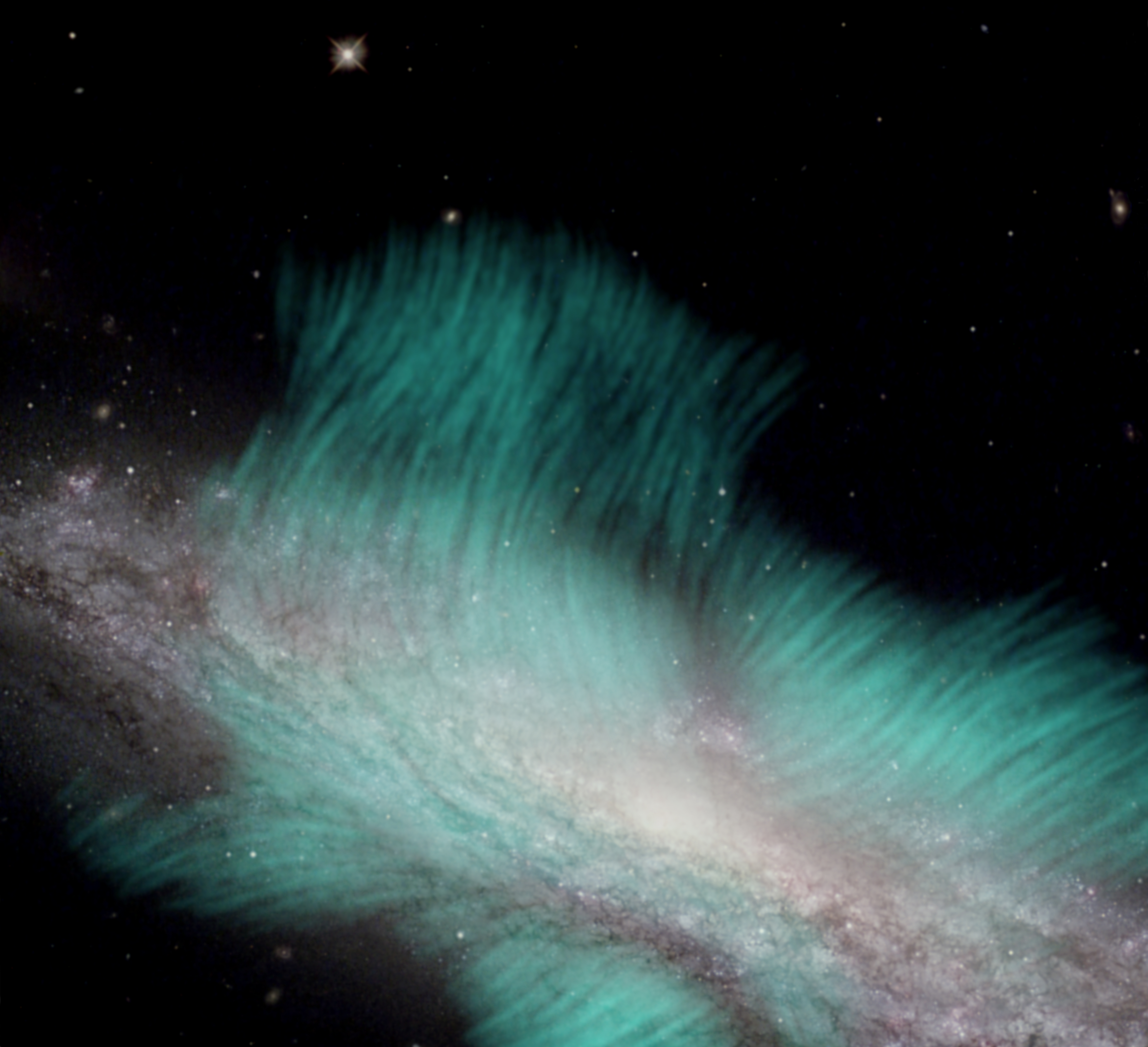
Honorable Mention: Magnetic Field of the Galaxy NGC 4666
The spiral galaxy NGC 4666 produces many more stars than our own galaxy, the Milky Way. This so-called starburst leads to strong forces within the disk that eject charged particles, dust, and gas. More remarkably they cause the disk’s magnetic field to stretch into the galaxy’s upper atmosphere, called the “halo.” This image shows the enormous size and importance of NGC 4666’s magnetic field (in green), which is extended more than 22,000 light-years, revealed by the National Science Foundation’s Karl G. Jansky Very Large Array (VLA) radio telescope.
Strong and extended magnetic fields also are observed in other starbursting spiral galaxies. NGC 4666, at 86 million light-years distance, is relatively nearby and therefore can be studied in detail. It is also special because, like the Milky Way, it is the only other galaxy, where scientists have found a changing direction of magnetic fields within the disk. Additionally it is gravitationally interacting with two smaller galaxies and a dwarf galaxy. Such gravitational tugs on galaxies are understood to initiate starbursts and, in turn, lead to forces that will stretch the magnetic field into the halos as visible in this image.
Credit:
Composite image by Yelena Stein of the Centre de Données astronomiques de Strasbourg (CDS), support by J. English (University of Manitoba). VLA radio data from Yelena Stein and Ralf-Juergen Dettmar (Ruhr-University Bochum). The observations are part of the project Continuum HAlos in Nearby Galaxies — an EVLA Survey (CHANG-ES) led by Judith Irwin (Queen’s University, Canada). The optical data are from the Hubble Space Telescope (HST) Wide Field Camera 3 (WFC3)/UVIS camera. The ionized hydrogen data (magenta) are from the 1.5m telescope of the Cerro Tololo Inter-American Observatory, collected by Matthew D. Lehnert. The software code for tracing the magnetic field lines was adapted by Y. Stein and Arpad Miskolczi (Ruhr-University Bochum) from the scipy Linear Integral Convolution code (https://scipy-cookbook.readthedocs.io/items/LineIntegralConvolution.html). The National Radio Astronomy Observatory is a facility of the National Science Foundation, operated under cooperative agreement by Associated Universities, Inc.
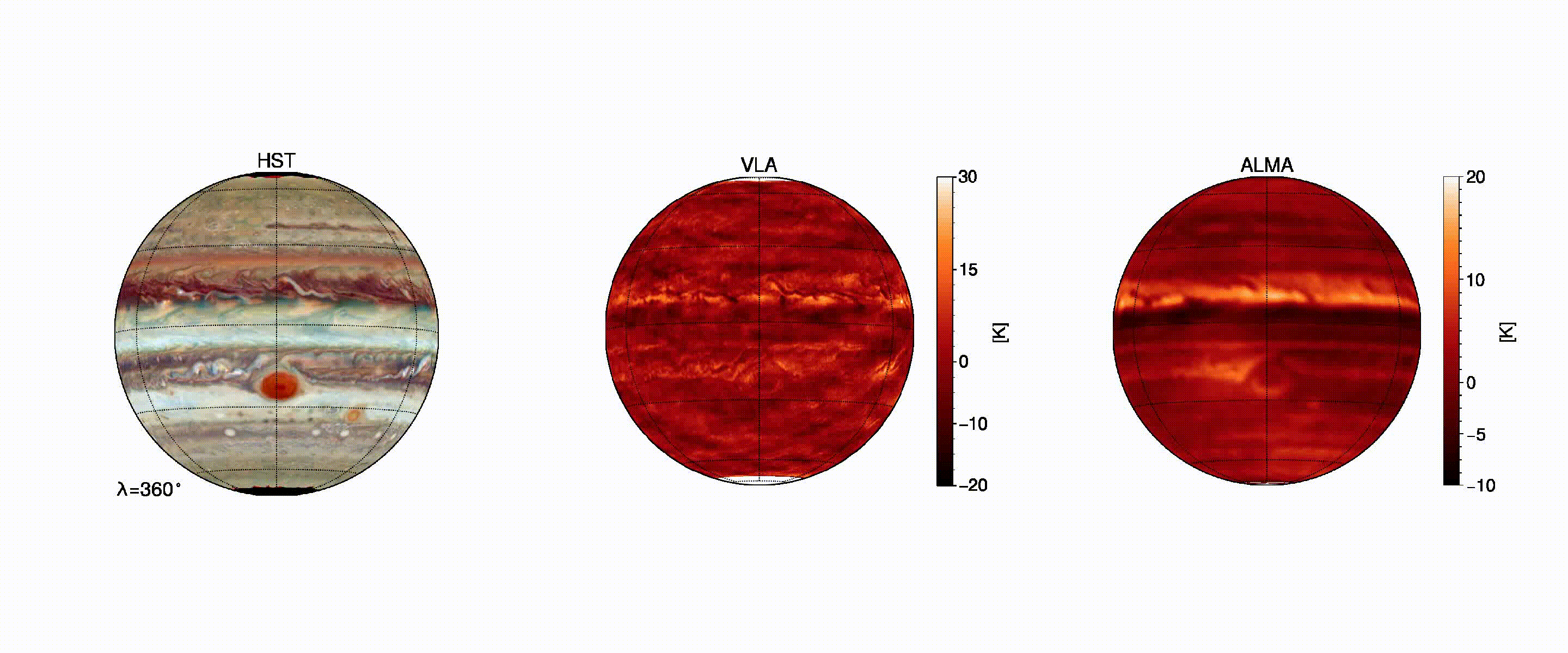
Honorable Mention: Jupiter: HST, VLA, ALMA
Observations with radio telescopes offer two major opportunities for planetary scientists. By observing with an array of telescopes, we can greatly improve the resolution of the observations compared to a single telescope, making use of a technique called interferometry. Secondly, radio observations are “blind” to clouds and can therefore see many tens of miles into the thick atmosphere of Jupiter.
The image on the left was taken with the Hubble Space Telescope and shows the alternating pattern of zones and belts on the planet, with storms ranging in size from the Great Red Spot to smaller storms all over the planet. But the secrets of these storms lie hidden deep below the storm deck. NRAO’s radio facilities such as the Very Large Array and the Atacama Large Millimeter/submillimeter Array open a window into the planet, revealing the sub-cloud atmosphere. If you can recognize features on all three images, these storms must originate somewhere deep in the planet’s atmosphere. These images hold clues for understanding what causes storms not only on Jupiter, but Earth as well.
Credit:
X-band observations with the NRAO’s Very Large Array (VLA) in A-configuration, and Band 6 observations with the Atacama Large Millimeter/submillimeter Array (ALMA), HST. Chris Moeckel, UC Berkeley; Imke de Pater (UC Berkeley); Bob Sault (University of Melbourne/NRAO); Mike Wong (UC Berkeley); and Bryan Butler (NRAO).
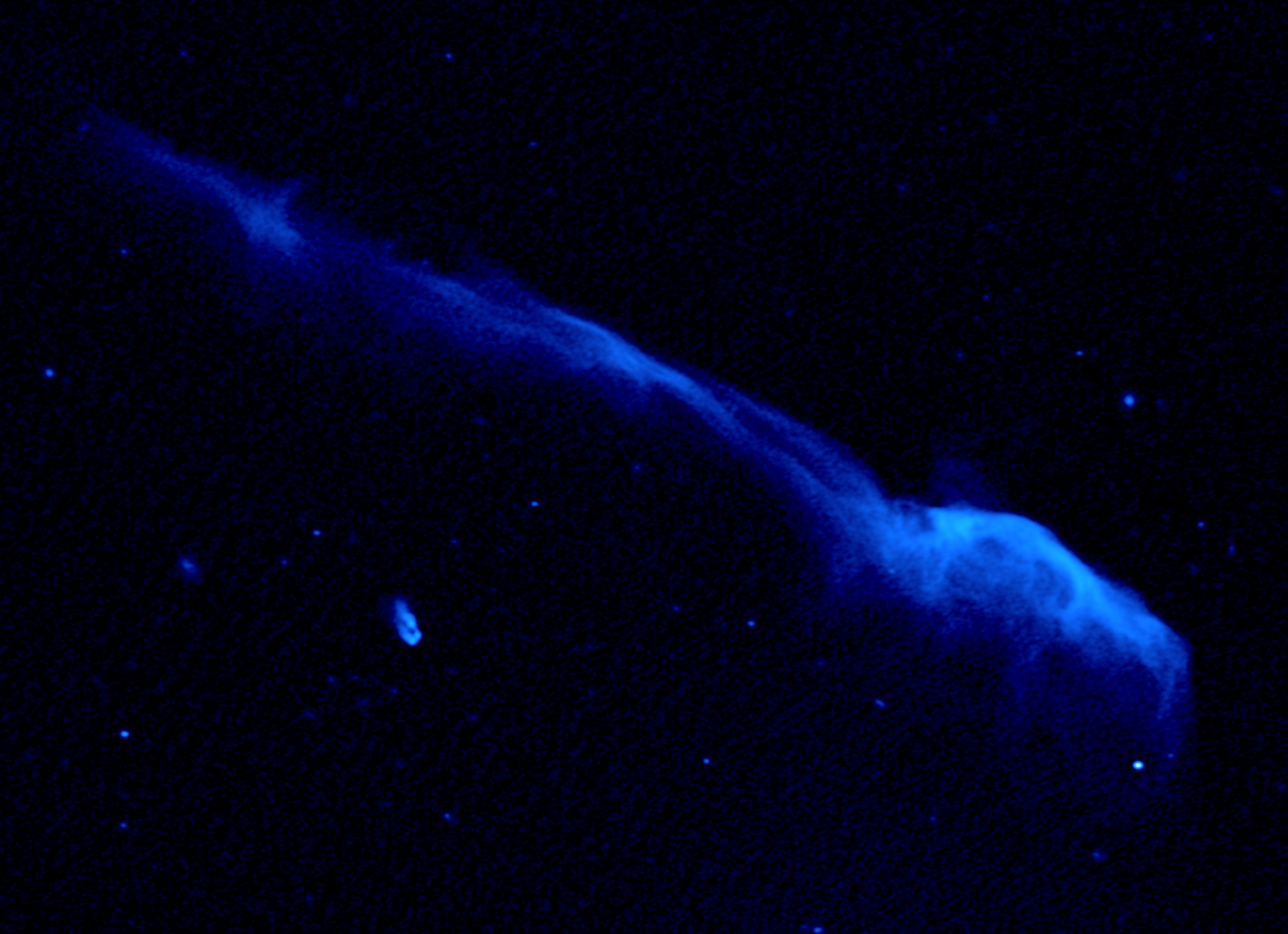
Honorable Mention: "Toothbrush" radio relic in the galaxy cluster 1RXS J0603.3+4214
Galaxy clusters are the largest gravitationally bound structures of the Universe. They grow by merging with two or more clusters, each containing thousands of galaxies. The radio observations of galaxy clusters have revealed sources of diffuse emission in the outskirts of galaxy clusters known as “radio relics.” These radio-emission sources are millions of light-years across and filled with the gas (known as intracluster medium (ICM) filling the space between the galaxies superheated to 10 to 100 millions Kelvins. Radio relics trace shock waves induced in the ICM during cluster merger events, leading eventually to the acceleration of particles in the presence of magnetic field. As a result, these particles emit synchrotron radiation which is visible with radio telescopes.
We observed one of the complex merging galaxy cluster with the VLA. Our images demonstrated how observations with the VLA can significantly advance our knowledge about radio relics and cosmic magnetism. The deep VLA observation shows the spectacular “Toothbrush” radio relic in unprecedented detail, revealing enigmatic filamentary structures on various scales. These filaments are most likely caused by the magnetic field distribution in the cluster periphery and projection effects. They allowed us to shed light on the particle acceleration mechanisms, strength of the magnetic fields, and their possible origins.
Credit: These findings are published in
[1] Rajpurohit, K., et al. “Deep VLA observations of the cluster 1RXS J0603. 3+ 4214 in the frequency range of 1–2 GHz.” The Astrophysical Journal 852.2.65, 2018.
[2] Rajpurohit, K., et al. “New mysteries and challenges from the Toothbrush relic: wideband observations from 550 MHz to 8 GHz”, Astronomy and Astrophysics, vol. 636. 2020.

Honorable Mention: WISE/VLA Galactic Plane
This image shows data by NASA’s WISE mission, an infrared space telescope, and radio observations that were part of the VLA Galactic Plane Survey (VGPS). The infrared data is shown in a colored image and the VLA data is shown in a violet overlay. The image shows a part of the Milky Way in the constellation Scutum.
Three large bubbles stick out in the image and those are supernova remnants. The brightest source in the VLA part of the image (large blob below the galactic plane) is a pulsar, called PSR J1833-1034. The infrared part of the image shows star-forming regions and tiny infrared bow shocks (red or orange) around runaway stars. The image shows how complex our Milky Way galaxy is. It is home to many different types of objects and the Very Large Array observed one part of this complex picture.
Credit: unWISE and VGPS: The WISE data are processed in a new way by researchers, enabling an unblurred view on the infrared sky. The data can be acessed via http://unwise.me/
The VGPS mapped neutral atomic hydrogen (HI) and 21 cm continuum. VGPS products can be accessed via http://www.ras.ucalgary.ca/VGPS/index.html










